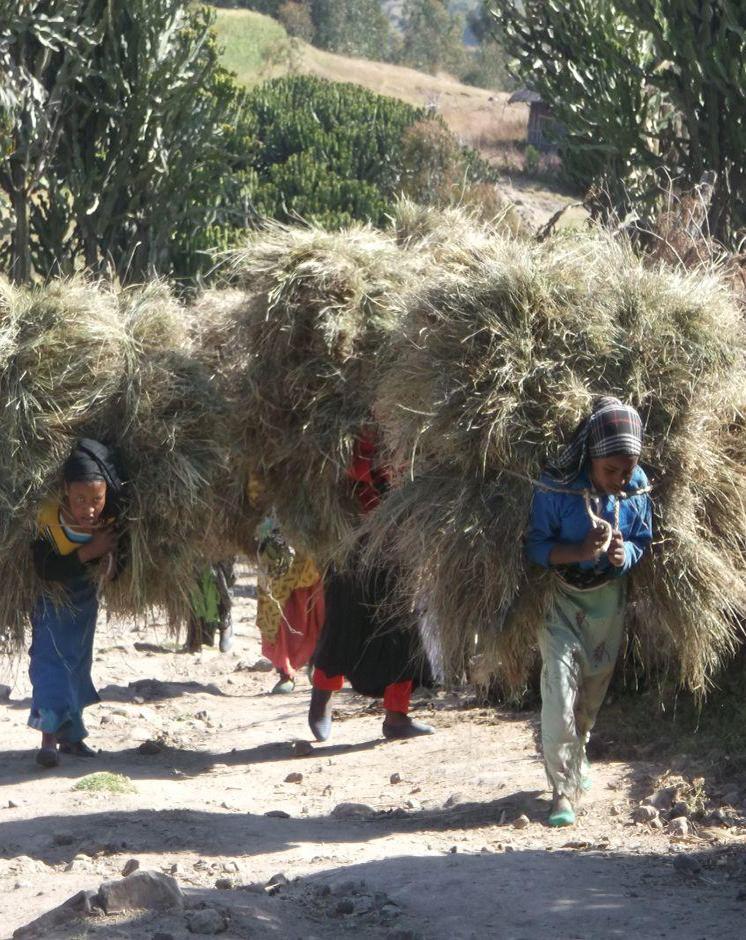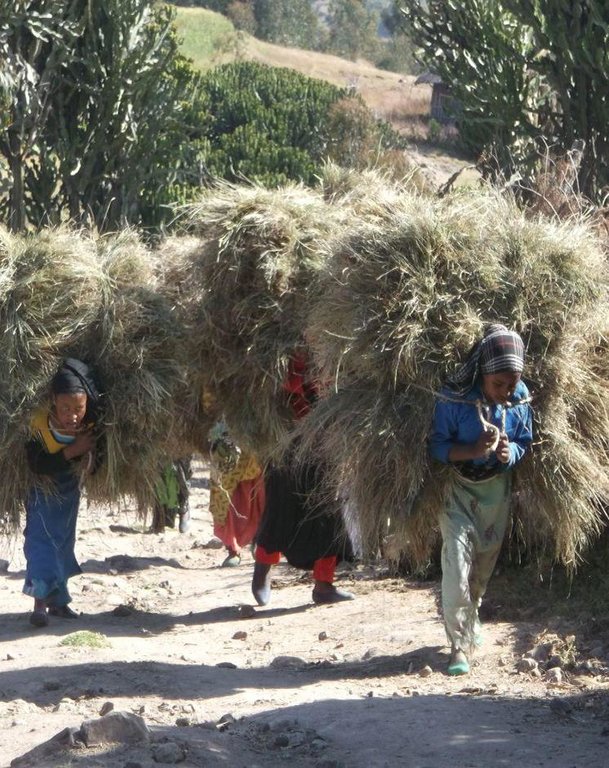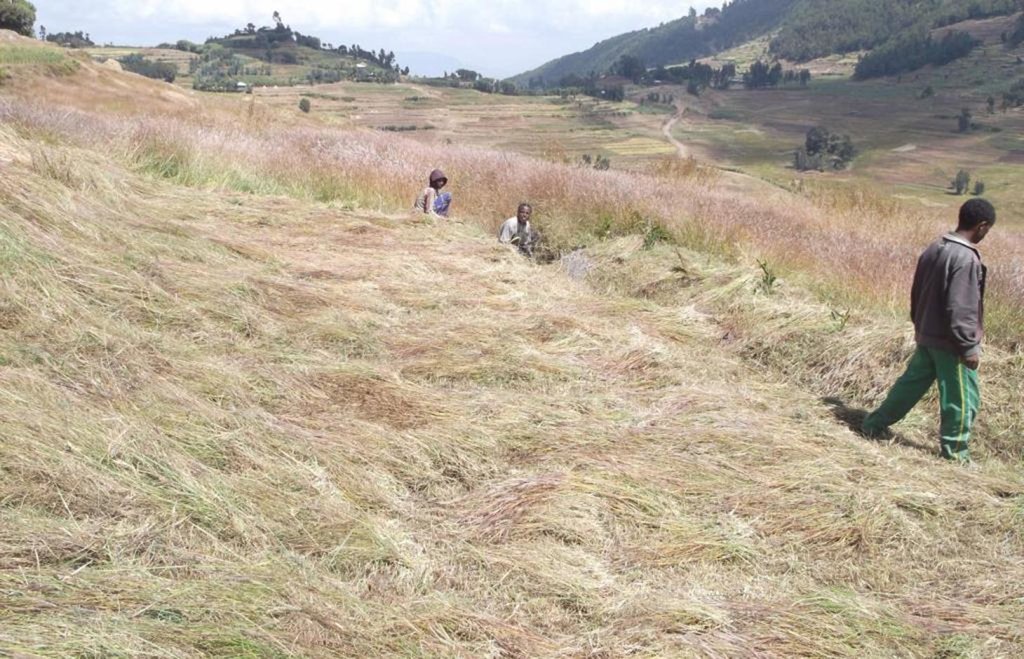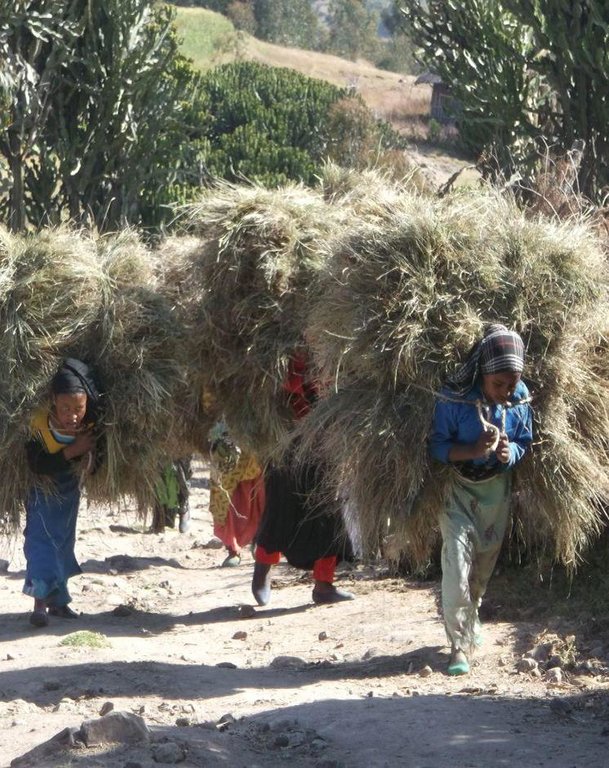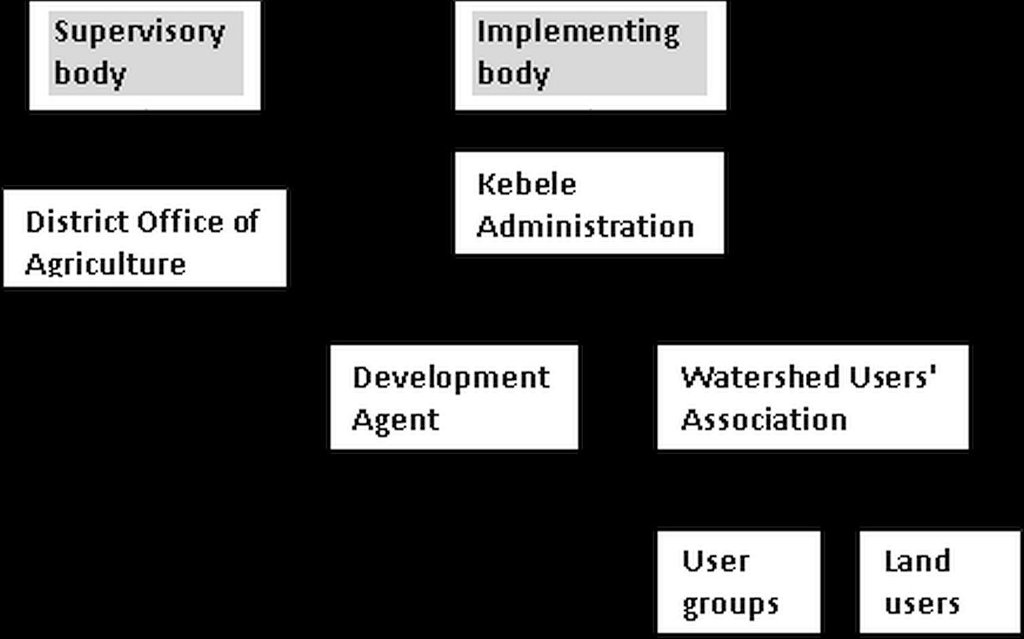'Cut and Carry' Grazing system or 'Zero Grazing' (CCG) [ប្រទេសអេត្យូពី]
- ការបង្កើត៖
- បច្ចុប្បន្នភាព
- អ្នកចងក្រង៖ Gizaw Desta Gessesse
- អ្នកកែសម្រួល៖ –
- អ្នកត្រួតពិនិត្យ Fabian Ottiger
Ensesa Asro Memgeb (Amharic)
approaches_2497 - ប្រទេសអេត្យូពី
ពិនិត្យមើលគ្រប់ផ្នែក
ពង្រីកមើលទាំងអស់ បង្រួមទាំងអស់1. ព័ត៌មានទូទៅ
1.2 ព័ត៌មានលម្អិតពីបុគ្គលសំខាន់ៗ និងស្ថាប័នដែលចូលរួមក្នុងការវាយតម្លៃ និងចងក្រងឯកសារនៃវិធីសាស្ត្រផ្សព្វផ្សាយ
អ្នកជំនាញឯកទេស SLM:
Melese Bekure
WLRC
ប្រទេសអេត្យូពី
ឈ្មោះអង្គភាពមួយ (ច្រើន) ដែលបានចងក្រងឯកសារ/ វាយតម្លៃលើវិធីសាស្ត្រផ្សព្វផ្សាយ (បើទាក់ទង)
Water and Land Resource Centre (WLRC) - ប្រទេសអេត្យូពី1.3 លក្ខខណ្ឌទាក់ទងទៅនឹងការប្រើប្រាស់ទិន្នន័យដែលបានចងក្រងតាមរយៈវ៉ូខេត
តើពេលណាដែលទិន្នន័យបានចងក្រង (នៅទីវាល)?
16/05/2014
អ្នកចងក្រង និង(បុគ្គលសំខាន់ៗ)យល់ព្រមទទួលយកនូវលក្ខខណ្ឌនានាទាក់ទងទៅនឹងការប្រើប្រាស់ទិន្នន័យដែលបានចងក្រងតាមរយៈ វ៉ូខេត:
បាទ/ចា៎
1.4 ការយោងមួយ (ច្រើន) ទៅលើ (កម្រង) បញ្ជីសំណួរនៃបច្ចេកទេស SLM
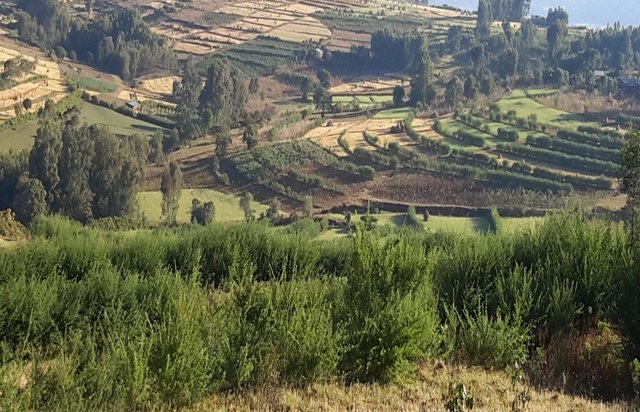
Vegetated graded soil bund [ប្រទេសអេត្យូពី]
Vegetated graded soil bund is a soil conservation practice meant for cultivated lands and constructed by excavating graded channel on upper side and develop embankment on lower side which is planted with grass or shrub species in order to control soil erosion and drain excess runoff implemented through community mobilization.
- អ្នកចងក្រង៖ Gizaw Desta Gessesse
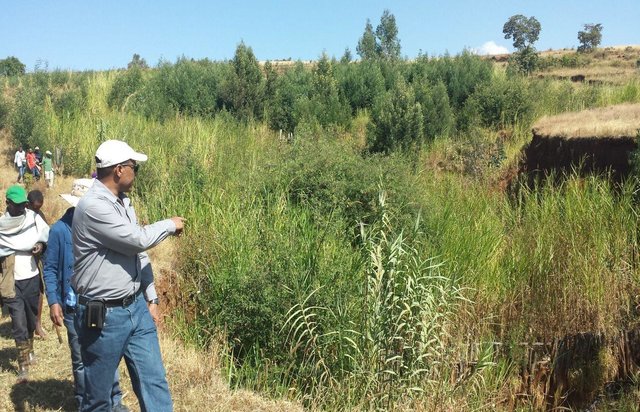
Gully erosion management [ប្រទេសអេត្យូពី]
Gully erosion management is the application of combination of practices to control excess or concentrated runoff generation in the gully upstream catchment area, divert excess runoff upstream of gully heads and control further development of gully using appropriate structural and vegetative measures in the head, bed and sides of the …
- អ្នកចងក្រង៖ Gizaw Desta Gessesse
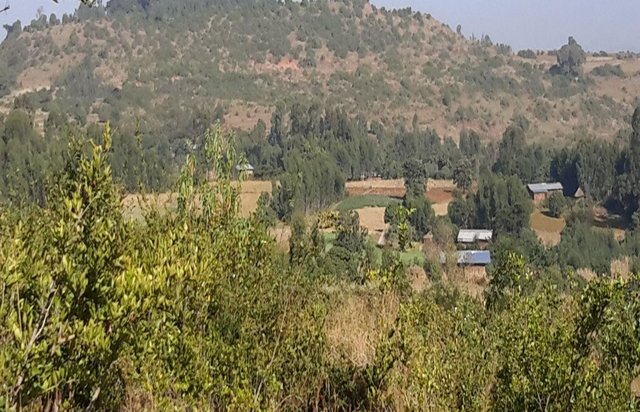
Area closure on degraded lands [ប្រទេសអេត្យូពី]
Area closure on degraded lands is a land management practice used to rehabilitate and conserve the natural resource bases, and enhance its natural regeneration and restoring capacity and productive functions by excluding animal and human interferences through community consultation and collective actions.
- អ្នកចងក្រង៖ Gizaw Desta Gessesse
2. ការពណ៌នាអំពីវិធីសាស្ត្រផ្សព្វផ្សាយ SLM
2.1 ពណ៌នាសង្ខេបខ្លីពីវិធីសាស្ត្រផ្សព្វផ្សាយ
Cut and carry grazing system (alternatively called zero grazing) is an approach where the community is consulted to identify and agree on areas to be closed and protected from free grazing; establish user groups are established to share the fodder biomass harvested from communal closed areas equitably; they utilize tree/shrub fodder planted on bunds.
2.2 ពណ៌នាលម្អិតពិវិធីសាស្ត្រផ្សព្វផ្សាយ
ពណ៌នាលម្អិតពិវិធីសាស្ត្រផ្សព្វផ្សាយ:
Aims / objectives: Zero grazing aims to reduce the impact of livestock management on land degradation. The objectives are: 1) implement cut and carry grazing system by establishing user groups for equitable share of biomass, 2) increase forage quantity and quality by improving the fodder and grass biomass production per unit area, 3) Protect further soil degradation and vegetation loss
Methods: Cut and carry employs series discussion with community to identify zero grazing sites and set bylaws to implement the approach. The watershed committee together with Development Agents and Kebele administration consult the community to identify and decide on the right beneficiaries of benefits gained from closed communal areas. Once the community agrees on the bylaws, the Kebele unit council approved and passed to district court for endorsement. The watershed committee, now renamed as Watershed Users Association, is the legitimate body authorized to regulate watershed management and benefit sharing among entitled users. The money collected from penalty fee from those who violate the rules use as a revolving fund to be used for other watershed development activities. The beneficiaries organize themselves into groups and they divided the benefits on equaitable basis at every harvest season. The users keep their animals around homes or sheds and feed them on harvested fodder/grass.
Stages of implementation: 1. Consultation and discussion with community in order to identify areas free from livestock access, formulate bylaws, control free grazing, and protect the developed watersheds from livestock interference,
2. Identification and organization of right beneficiaries into user groups who actually used to benefit previously on the selected area and new users that are believed to share the benefit,
3. Undertaking treatment of area closures with biological, structural and land use management measures as well as planting bunds on crop lands with fodder and grass species,
4. Watershed Committee start to implement or enforce the agreed bylaws on those who violate the rules (allow livestock in the protected areas, harvest biomass or cut tree from closed areas by untitled users, etc.),
5. Utilization of the biomass by user group members through equal share of the harvested biomass.
Role of stakeholders: Community: The community was responsible to select closed areas from livestock interference, identify beneficiaries, harvest and utilize the biomass as per the agreement, and respect and comply with the rules/bylaws;
Development agents: Supported the watershed committee in regulating protected areas, provide technical advice in the implementing integrated watershed interventions and subsequent maintenance activities or operations, and provide awareness creation and training about fodder utilization;
Watershed committee/watershed users association: It played the key role in planning, managing the developed watershed and regulate the benefit utilization arrangements. It applies the rules for those who do not comply with;
Kebele administration: The administration was responsible to control and manage the overall activities and supervise the implementation
Command post: Both the district and kebele command post (adhoc committee) is responsible to supervise the activities and solve problems;
Research: research involved to take part in introducing improved technologies that increase biomass production (like improved species with high quality and biomass) and efficiency (harvesting and packaging implements);
Project/WLRC: Provided material and technical support for the planning, implementation and monitoring activities.
Other important information: Cut and carry grazing system is an important intervention in the Ethiopian farming system where livestock and crop farming are mixed and livestock husbandry is means of crop production and household asset. Livestock farming is a subsistence production, which is not yet commercialized.
2.3 រូបភាពនៃវិធីសាស្ត្រផ្សព្វផ្សាយ
2.5 ប្រទេស/តំបន់/ទីតាំងកន្លែង ដែលវិធីសាស្ត្រផ្សព្វផ្សាយត្រូវបានអនុវត្តន៍
ប្រទេស:
ប្រទេសអេត្យូពី
តំបន់/រដ្ឋ/ខេត្ត:
Amhara National Regional State
បញ្ជាក់បន្ថែមពីលក្ខណៈនៃទីតាំង:
Bahir Dar Zuria, Mecha, Yilmna Densa, Dessie Zuria
2.6 កាលបរិច្ឆេទនៃការចាប់ផ្តើម និងបញ្ចប់នៃវិធីសាស្រ្តផ្សព្វផ្សាយនេះ
សូមបញ្ជាក់ឆ្នាំដែលបានបង្កើតឡើង:
2011
2.7 ប្រភេទនៃវិធីសាស្ត្រផ្សព្វផ្សាយ
- ផ្អែកលើគម្រោង/កម្មវិធី
2.8 គោលបំណង/ទិសដៅសំខាន់នៃវិធីសាស្ត្រផ្សព្វផ្សាយ
The Approach focused on SLM only
The main objectives of cut and carry or zero grazing is protection of land degradation and loss of vegetation on communal lands and controlling damage on the soil and water conservation measures implemented on watersheds. Specifically, it is to practice cut and carry feeding system by establishing equitable share of biomass among user groups, increase quantity and quality of forage, and protect further degradation of land and loss of vegetation.
The SLM Approach addressed the following problems: The main problems targeted to address by implementing cut and carry or zero grazing approach are: growing challenges of land degradation due to overgrazing and compaction/trampling effects; growing shortage of livestock feed; lack of communal land resource management regulation and actions.
2.9 លក្ខខណ្ឌអនុញ្ញាត ឬរារាំងការអនុវត្តន៍បច្ចេកទេសដែលស្ថិតនៅក្រោមវិធីសាស្រ្តផ្សព្វផ្សាយ
ភាពអាចរកបាននៃធនធានហិរញ្ញវត្ថុ និងសេវាកម្ម
- រារាំង
Inadequate diversification of income from livestock production due to its low carrying capacity of the grazing lands, low input and technology supply as well as low financial capacity of farmers
Treatment through the SLM Approach: Zero grazing approach helps to increase livestock productivity and attain better weight gain for market.
បរិបទនៃស្ថាប័ន
- រារាំង
Lack of common property management and regulation to share benefits equitably among users. There is reluctance to respect local initiated bylaws to stop free grazing.
Treatment through the SLM Approach: Watershed committee is institutionalized to govern zero grazing implementation procedures and entitle use rights to right beneficiaries in a group.
ក្របខណ្ឌច្បាប់ (សិទ្ធិកាន់កាប់ដីធ្លី កម្មសិទ្ធីប្រើប្រាស់ដីនិងទឹក)
- រារាំង
The existing land ownership, land use rights / water rights moderately hindered the approach implementation Since there is tradition of open access grazing (animals allowed to graze freely) and pasture lands are communally used, this tradition affects the sustainability of the approach. Although there are community bylaws attempted to enforce through the watershed committee, farmers not yet fully practice cut and carry system of grazing. This, because they wanted to maximize the benefit by entitling individual use rights for communal land resources.
ចំណេះដឹងស្តីពី SLM និងការទទួលបានការគាំទ្រផ្នែកបច្ចេកទេស
- រារាំង
Lack of immediate feed options and lack of knowledge of improved fodder production and forage utilization.
Low level of understanding about multiple advantages of zero grazing. Degradation of natural resources in the form of compaction, loss of organic matter and soil erosion and damage to grass and plant biodiversity.
Treatment through the SLM Approach: The approach support to build the skill and knowledge of users about the forage production and utilization techniques by research actors as well it enables to understand feed requirement per household.
3. ការចូលរួម និងតួនាទីរបស់ភាគីពាក់ព័ន្ធ
3.1 អ្នកពាក់ព័ន្ធដែលបានចូលរួមក្នុងវិធីសាស្ត្រផ្សព្វផ្សាយ និងតួនាទីរបស់ពួកគេ
- អ្នកប្រើប្រាស់ដីក្នុងតំបន់/សហគមន៍
The watershed Users Association, kebele administration and development agents
Individual land users has to play role to control free grazing and practice zero grazing. The closed areas are owned in group and need to protect and control in group. The role of men was mainly dedicated to control free grazing activities and involved in harvesting forage. Women were involved in the plantation of vegetative measures, in bunds and area closures, they took care of animals around their homestead, sometimes they transported forage/biomass for livestock. The approach entitled those who do not own animals to share the biomass collected from communal closed areas. They earned cash by selling the biomass harvest for forage purpose.
- អ្នកឯកទេសគ្រប់គ្រងដីប្រកបដោយចីរភាព/ទីប្រឹក្សាបច្ចេកទេសកសិកម្ម
They are involved in the planning, support and supervision of the implementation, monitoring and evaluating the implementation
- រដ្ឋាភិបាលថ្នាក់មូលដ្ឋាន
The district agriculture office
- រដ្ឋាភិបាលថ្នាក់ជាតិ (អ្នករៀបចំផែនការ អ្នកសម្រេចចិត្ត)
Decision makers
They play role to enforce the rules and mobilize the community to control free grazing
3.2 ការចូលរួមរបស់អ្នកប្រើប្រាស់ដីក្នុងតំបន់/ សហគមន៍ក្នុងតំបន់ក្នុងដំណាក់កាលផ្សេងគ្នានៃវិធីសាស្រ្តផ្សព្វផ្សាយ
| ការចូលរួមរបស់អ្នកប្រើប្រាស់ដីក្នុងតំបន់/សហគមន៍ក្នុងតំបន់ | សូមបញ្ជាក់នរណាត្រូវបានចូលរួម ព្រមទាំងពណ៌នាសកម្មភាពទាំងនោះ | |
|---|---|---|
| ការចាប់ផ្តើម/ការលើកទឹកចិត្ត | គ្មាន | |
| ការរៀបចំផែនការ | អន្តរកម្ម | The community and individual land users agree to delineate areas closed from free grazing. At this stage land users should involve and agree. |
| ការអនុវត្តន៍ | អន្តរកម្ម | land users need to participate and involve actively to control free grazing and practice cut and carry feeding system. |
| ការត្រួតពិនិត្យ និងវាយតម្លៃ | អន្តរកម្ម | Land users are involved in the evaluation and field days. |
| Research | អន្តរកម្ម | Land users are involved in participatory technology generation and promotion. |
3.3 គំនូសបំព្រួញ (ប្រសិនបើមាន)
ការពណ៌នា:
The district office of agriculture together with its Kebele unit is the supervisory body for implementing cut and carry or zero grazing approach. The main implementers are the kebele administration, the watershed users' association and development agents. The Watershed Users' Association (WUA) or sometimes called watershed committee is the implementer of the daily activities or operations to manage and regulate developed watersheds and specifically zero grazing approach by enforcing the agreed bylaws. The Kebele administration unit support and manage administrative matters associated to zero grazing while the development agents assist the WUA and user groups on technical issues. User groups and land users are part of the implementation of the processes.
អ្នកនិពន្ធ:
Gesesse, Gizaw Desta (WLRC, P.O.Box 8707, Addis Abeba, Ethiopia)
3.4 ការសម្រេចចិត្តលើការជ្រើសរើសបច្ចេកទេស SLM
សូមបញ្ជាក់តើអ្នកណាជាអ្នកបានសម្រេចចិត្តក្នុងការជ្រើសរើសបច្ចេកទេសដើម្បីយកមកអនុវត្តន៍:
- អ្នកជំនាញឯកទេស SLM បន្ទាប់ពីបានប្រឹក្សាយោបល់ជាមួយអ្នកប្រើប្រាស់ដី
ចូរពន្យល់:
Decisions on the method of implementing the SLM Technology were made by mainly by SLM specialists with consultation of land users
4. ជំនួយបច្ចេកទេស ការកសាងសមត្ថភាព និងការគ្រប់គ្រងចំណេះដឹង
4.1 ការកសាងសមត្ថភាព/ បណ្តុះបណ្តាល
តើវគ្គបណ្តុះបណ្តាលបានផ្តល់ឱ្យអ្នកប្រើប្រាស់ដី/អ្នកពាក់ព័ន្ធផ្សេងៗទៀតដែរឬទេ?
បាទ/ចា៎
សូមបញ្ជាក់តើអ្នកណាត្រូវបានបណ្តុះបណ្តាល:
- អ្នកប្រើប្រាស់ដី
- បុគ្គលិកចុះទីវាល/អ្នកផ្តល់ប្រឹក្សាយោបល់
- leaders at local level
ប្រសិនទាក់ទង សូមបញ្ជាក់ ភេទ អាយុ ស្ថានភាពគ្រួសារ ជនជាតិដើមភាគតិច។ល។:
Awareness creation is provided to all land users both men and women, development staff and local leaders.
ទម្រង់នៃការបណ្តុះបណ្តាល:
- ពីកសិករទីកសិករ
- ទីតាំងបង្ហាញ
- ការប្រជុំជាសាធារណៈ
ប្រធានបទបណ្តុះបណ្តាល:
Magnitude and extent of land degradation and the impact of livestock pressure on depletion of natural resources. The community was advised to reduce livestock number and to rely on small number of improved breeds supplemented with intensive forage production and treated crop residues. Development staff was involved in trainings about forage production and management. Leaders also took part in trainings and awareness workshops about land degradation and natural resources conservation.
4.2 សេវាផ្តល់ប្រឹក្សាយោបល់
តើអ្នកប្រើប្រាស់ដីបានទទួលនូវសេវាផ្តល់ប្រឹក្សាដែរ ឬទេ?
បាទ/ចា៎
សូមបញ្ជាក់ប្រសិនបើសេវាកម្មប្រឹក្សាយោបល់ត្រូវបានផ្តល់ឱ្យ:
- នៅមជ្ឈមណ្ឌលជាអចិន្ត្រៃ
ពណ៌នា/ពន្យល់:
Name of method used for advisory service: Participatory Demonstration and Training Extension System (PADETES); Key elements: Training and awareness creation of farmers in Farmer Training Centers (FTC), Provision of inputs and package, and demonstrations on the Farmer Training Centers (FTC) and experience sharing visits, On job training; The method gives high emphasis to training and to some extent practical demonstrations supported with experience
sharing visits but less emphasis to advisory of farmers on site.
Advisory service is quite adequate to ensure the continuation of land conservation activities; The extension system is quite adequate to ensure continuation of activities. The government service is adequate to ensure the implementation. Furthermore, if the newly structured and formulated Watershed Users Association functions well, it is sufficient to regulate the approach and sustain land conservation.
4.3 ការពង្រឹងសមត្ថភាពស្ថាប័ន (ការអភិរឌ្ឍន៍អង្គភាព)
តើស្ថាប័នទាំងអស់ត្រូវបានបង្កើតឡើង ឬពង្រឹងសមត្ថភាពតាមរយៈវិធីសាស្ត្រផ្សព្វផ្សាយដែរ ឬទេ?
- បាទ/ច៎ា ជាមធ្យម
សូមបញ្ជាក់ថាតើស្ថាប័នត្រូវបានពង្រឹង ឬបង្កើតឡើងនៅត្រឹមកម្រិតណា(ច្រើន)?
- ថ្នាក់មូលដ្ឋាន
សូមបញ្ជាក់ប្រភេទនៃការគាំទ្រ:
- ការកសាងសមត្ថភាព/ បណ្តុះបណ្តាល
សូមផ្តល់ព័ត៌មានបន្ថែមទៀតឱ្យបានលម្អិត:
The support is mainly awareness creation and training. The local institutions like watershed users association, User Groups, Farmer Training Centers are supported by training.
4.4 ការត្រួតពិនិត្យ និងវាយតម្លៃ
តើការត្រួតពិនិត្យ និងវាយតម្លៃគឺជាផ្នែកមួយនៃវិធីសាស្ត្រដែរឬទេ?
បាទ/ចា៎
មតិយោបល់:
bio-physical aspects were ad hoc monitored by project staff, government, land users through observations; indicators: Free grazing by animals; land users who practice zero grazing
bio-physical aspects were regular monitored by project staff through measurements; indicators: Forage biomass harvested and shared among the land users
technical aspects were ad hoc monitored by project staff, government, land users through observations; indicators: Fattening practice; change in animal body performance
socio-cultural aspects were ad hoc monitored by project staff through observations; indicators: Formation of User Groups and share of benefits; Conflict reduction; role of actors
economic / production aspects were ad hoc monitored by project staff, government through observations; indicators: Fattening benefits;
area treated aspects were ad hoc monitored by project staff through observations; indicators: Area covered by zero grazing
no. of land users involved aspects were ad hoc monitored by project staff, land users through observations; indicators: Land users who practice zero grazing or who voilate the rules
management of Approach aspects were regular monitored by None through measurements; indicators: Damage to treated areas by free grazing
There were several changes in the Approach as a result of monitoring and evaluation: As a result of monitoring and evaluation the practice of zero grazing is expanded. Strict enforcement of the bylaws brought change in zero grazing practices and some also attempted to reduce their livestock number
There were no changes in the Technology as a result of monitoring and evaluation
4.5 ការស្រាវជ្រាវ
តើការស្រាវជ្រាវ គឺជាផ្នែកមួយនៃវិធីសាស្រ្តដែរឬទេ?
បាទ/ចា៎
បញ្ជាក់ប្រធានបទ:
- បរិស្ថានវិទ្យា
- បច្ចេកវិទ្យា
សូមផ្តល់ព័ត៌មានបន្ថែមទៀតឱ្យបានលម្អិត និងចង្អុលបង្ហាញនរណាដែលបានធ្វើការស្រាវជ្រាវ:
The research support is most of the time in form of on-farm research. Research is part of the approach. The research provides technical backstopping by introducing improved agricultural technologies like improved forage species and breeds that complement the SLM technologies where the approach is designed for.
Research was carried out on-farm
5. ថវិកា និងសម្ភារៈឧបត្ថម្ភពីខាងក្រៅ
5.1 ថវិកាប្រចាំឆ្នាំសម្រាប់ផ្សព្វផ្សាយ SLM
ប្រសិនបើចំនួនពិតប្រាកដនៃថវិកាប្រចាំឆ្នាំមិនត្រូវបានដឹងច្បាស់ សូមប្រាប់ពីចន្លោះនៃថវិកានោះ:
- 10,000-100,000
មតិយោបល់ (ឧ. ប្រភពសំខាន់នៃមូលនិធិ/ម្ចាស់ជំនួយចំបង):
Approach costs were met by the following donors: local government (district, county, municipality, village etc) (Through technical and material support and capacity building): 28.0%; local community / land user(s) (For scouting by Watershed Users Association, free labor for implementation, and sometimes wage for guards): 72.0%
5.2 ការគាំទ្រផ្នែកហិរញ្ញវត្ថុ / សម្ភារៈដែលបានផ្តល់ទៅឱ្យអ្នកប្រើប្រាស់ដី
តើអ្នកប្រើប្រាស់ដីបានទទួលការគាំទ្រផ្នែកហិរញ្ញវត្ថ/សម្ភារៈសម្រាប់ការអនុវត្តន៍បច្ចេកទេសដែរឬទេ:
បាទ/ចា៎
ប្រសិនបាទ/ច៎ា សូមបញ្ជាក់ប្រភេទ(ច្រើន)នៃការគាំទ្រ លក្ខខណ្ឌ និងអ្នកផ្តល់ឱ្យ(ច្រើន):
The inputs like seedlings and grass splits raised in the nurseries for the implementation of vegetative measures and other technologies that support the efficiency and management of the SLM technologies are supported by the government and/or projects.
5.3 សូមបញ្ជាក់ពីធាតុចូលត្រូវបានផ្តល់បដិភាគ (រួមទាំងកម្លាំងពលកម្ម)
- សម្ភារៈ
| សូមបញ្ជាក់ ធាតុចូលណាខ្លះដែលបានផ្តល់បដិភាគ | កម្រិតទំហំប៉ុណ្ណា | សូមបញ្ជាក់ពីការបដិភាគ |
|---|---|---|
| ឧបករណ៍ | ផ្តល់ហិរញ្ញវត្ថុមួយផ្នែក | Hand tools for construction |
- កសិកម្ម
| សូមបញ្ជាក់ ធាតុចូលណាខ្លះដែលបានផ្តល់បដិភាគ | កម្រិតទំហំប៉ុណ្ណា | សូមបញ្ជាក់ពីការបដិភាគ |
|---|---|---|
| គ្រាប់ពូជ | ផ្តល់ហិរញ្ញវត្ថុទាំងស្រុង | Tree seedlings and grasses |
ប្រសិនបើកម្លាំងពលកម្មធ្វើដោយអ្នកប្រើប្រាស់ដី តើវាជាធាតុចូលដ៏សំខាន់មួយដែរ ឬទេ:
- ដោយស្ម័គ្រចិត្ត
មតិយោបល់:
The labor is totally contributed by land users voluntarily through community mobilization approach.
5.4 ឥណទាន
តើឥណទានដែលបានផ្តល់នៅក្រោមវិធីសាស្ត្រផ្សព្វផ្សាយសម្រាប់សកម្មភាព SLM នេះយ៉ាងដូចម្តេច?
ទេ
6. ការវិភាគរកផលប៉ះពាល់ និងសេចក្តីសន្និដ្ឋាន
6.1 ផលប៉ះពាល់នៃវិធីសាស្ត្រផ្សព្វផ្សាយ
តើវិធីសាស្ត្រផ្សព្វផ្សាយជួយអ្នកប្រើប្រាស់ដីដើម្បីអនុវត្តន៍ និងថែទាំបច្ចេកទេស SLM?
- ទេ
- បាទ/ច៎ា បន្តិចបន្តួច
- បាទ/ច៎ា ជាមធ្យម
- បាទ/ច៎ា បានខ្លាំង
The approach aim to rehabilitate unproductive and degraded lands and thereby the soil moisture and biomass productivity improve. It also helps to increase the level of awareness to protect and manage communal resources and share of benefits out of it. It also gradually increases the ecosystem services such as increase the duration of flow of streams, increase stream flow and water availability, improve the diversity of plant species, and improve the micro-climatic conditions.
តើវិធីសាស្ត្រផ្សព្វផ្សាយនេះផ្តល់សិទ្ធិអំណាចដល់សង្គមនិងសេដ្ឋកិច្ចដែលក្រុមមិនទទួលបានផលប្រយោជន៍?
- ទេ
- បាទ/ច៎ា បន្តិចបន្តួច
- បាទ/ច៎ា ជាមធ្យម
- បាទ/ច៎ា បានខ្លាំង
Land users who do not have animals also share the benefit equally with the land users who own animals. Thus, they improve their situation by selling grass biomass for feed. Others also employed to prepare and raise tree and grass seedlings in nurseries.
តើវិធីសាស្ត្រផ្សព្វផ្សាយបានឱ្យប្រសើរឡើងនូវបញ្ហាកាន់កាប់ដីធ្លី/សិទ្ធិអ្នកប្រើប្រាស់ដែលរារាំងដល់ការអនុវត្ត SLM?
- ទេ
- បាទ/ច៎ា បន្តិចបន្តួច
- បាទ/ច៎ា ជាមធ្យម
- បាទ/ច៎ា បានខ្លាំង
Forage biomass production and improved forage development were parts of the SLM technologies help to reduce the feed shortage problem. The approach is thus help to improve feed shortage by producing alternative fodder production strategies on bunds, gullies, area closures and backyards while controlling free grazing by implementing community agreed bylaws and setting entitlement to group use rights.
Did other land users / projects adopt the Approach?
- ទេ
- បាទ/ច៎ា បន្តិចបន្តួច
- បាទ/ច៎ា ជាមធ្យម
- បាទ/ច៎ា បានខ្លាំង
The cut and carry system is gradually expanded to adjacent watersheds and villages after sharing experiences during field days. Land users become aware of the benefits of cut and carry system on livestock production and health. Experts and leaders from other districts visited the approach and plan to expand to their areas.
Did the Approach lead to improved livelihoods / human well-being?
- ទេ
- បាទ/ច៎ា បន្តិចបន្តួច
- បាទ/ច៎ា ជាមធ្យម
- បាទ/ច៎ា បានខ្លាំង
In two years project life, some land users particularly youths involve in apiculture production using the areas closed for zero grazing, and some others practiced fattening using the biomass harvest from area closures and vegetated fodder trees on bunds.
Did the Approach help to alleviate poverty?
- ទេ
- បាទ/ច៎ា បន្តិចបន្តួច
- បាទ/ច៎ា ជាមធ្យម
- បាទ/ច៎ា បានខ្លាំង
Cut and carry or zero grazing approach allowed some land users to use improved animal breeds and fattening practices that increase productivity and reduce poverty.
6.2 ការលើកទឹកចិត្តចម្បងៗរបស់អ្នកប្រើប្រាស់ដីសម្រាប់ការអនុវត្តបច្ចេកទេស SLM
- បង្កើនផលិតកម្ម
The Immediate interest is to gain biomass harvest from area closures for livestock production
- ការចំណាយ/បដិភាគ
Some land users are motivated to gain in kind material support in kind like seeds, seedlings, breed
- ច្បាប់ និងបទបញ្ជា (ផាកពិន័យ)/ការប្រតិបត្តិ
Gain benefit through equitable share of benefits from area closures
- well-being and livelihoods improvement
Introduction of fattening and synchronization using improved fodder production for livestock
6.3 សកម្មភាពផ្សព្វផ្សាយដែលប្រកបដោយចីរភាព
តើអ្នកប្រើប្រាស់ដីអាចធ្វើឱ្យមានចីរភាពនូវអ្វីដែលត្រូវបានអនុវត្តន៍តាមរយៈវិធីសាស្ត្រផ្សព្វផ្សាយដែរឬទេ(ដោយពុំមានការគាំទ្រពីអ្នកខាងក្រៅ)?
- បាទ/ចា៎
ប្រសិនបាទ/ច៎ា សូមរៀបរាប់ថាធ្វើយ៉ាងម៉េច:
It can be sustained if adequate technology supply, effective capacity development, and regulatory systems become effective. Additional efforts on increasing the technical skill of farmers and especially for members of Watershed Users Association on regulatory practices by employing continuous awareness creation, training and demonstration activities.
6.4 ភាពខ្លាំង/ គុណសម្បត្តិនៃវិធីសាស្ត្រផ្សព្វផ្សាយ
| ភាពខ្លាំង/ គុណសម្បត្តិ/ ឱកាស ទស្សនៈរបស់អ្នកប្រើប្រាស់ដី |
|---|
| The approach give benefit to those who have less power within the community. (How to sustain/ enhance this strength: Strengthen and empower user groups in particular and watershed users' association in general.) |
| Improved body performance of the animals treated in zero grazing. (How to sustain/ enhance this strength: Provide continuous advisory services to land users in order to implement zero grazing and practice fattening.) |
| ភាពខ្លាំង/ គុណសម្បត្តិ/ ឱកាស ទស្សនៈរបស់បុគ្គលសំខាន់ៗ |
|---|
| Increase the attitude and knowledge of land users about land degradation and sustainable land management. (How to sustain/ enhance this strength: Launch continuous training sessions or capacity building activities in the Farmer Training Centers (FTC).) |
|
Degraded lands become rehabilitated and productive and off-site ecosystem services enhanced, and restore the lost plant biodiversity on degraded lands and waste lands. (How to sustain/ enhance this strength: Maintain interventions and comply with agreed bylaws. ) |
|
Strengthen grass root level institutions that govern the management of resources in watersheds. (How to sustain/ enhance this strength: Provide support and increase their technical and financial capacity.) |
|
Communal degraded lands are entitled to organized use rights and gives opportunity to those who do not access benefit from communal lands. (How to sustain/ enhance this strength: Strengthen the Watershed Users Association and user groups.) |
|
Enable to introduce improved livestock production system that improve livestock productivity as a result of controlled feeding and avoidance of long distance movement of animals and gradually change from subsistence to (semi) commercial production. (How to sustain/ enhance this strength: Provide technical support and link to market information and opportunities.) |
6.5 ភាពខ្សោយ/ គុណវិបត្តិនៃវិធីសាស្ត្រ និងរកដំណោះស្រាយ
| ភាពខ្សោយ/ គុណវិបត្តិ/ ហានិភ័យ ទស្សនៈរបស់អ្នកប្រើប្រាស់ដី | តើបច្ចេកទេសទាំងនោះបានដោះស្រាយបញ្ហាដូចម្តេច? |
|---|---|
| Zero grazing applies only when the number of animals per household is minimum while large livestock flock size is required to use for trampling and as a risk aversion mechanisms. | Options of agronomic practices without trampling and other agricultural implements that substitute trampling has to be introduced and adopted. |
| The approach has limitations in areas where there is forage constraints and shortage of communal land for grazing purposes. | Introduce intensive forage production systems (for example backyard) that improve productivity per unit area. |
| ភាពខ្សោយ/ គុណវិបត្តិ/ ហានិភ័យក្នុងទស្សនៈរបស់បុគ្គលសំខាន់ៗ | តើបច្ចេកទេសទាំងនោះបានដោះស្រាយបញ្ហាដូចម្តេច? |
|---|---|
| All land users were not equally committed and took accountability. | Motivate and engage them in every decision making process. |
| Inadequate support to watershed committee in enforcing the rules from higher level administrative units. | Establish forums or platforms for discussing challenges and solve problems. |
7. ឯកសារយោង និងវេបសាយ
7.1 វិធីសាស្ត្រ/ ប្រភពនៃព័ត៌មាន
- តាមការចុះទីវាល ការស្រាវជ្រាវនៅទីវាល
- ការសម្ភាសន៍ជាមួយអ្នកប្រើប្រាស់ដី
7.2 ឯកសារយោងដែលបានចេញផ្សាយ
ចំណងជើង អ្នកនិពន្ធ ឆ្នាំ ISBN:
Area closure. WLRC Brief No. 2 June 2015
មានប្រភពមកពីណា? ថ្លៃដើមប៉ុន្មាន?
www.wlrc-eth.org
ការតភ្ជាប់ និងម៉ូឌុល
ពង្រីកមើលទាំងអស់ បង្រួមទាំងអស់ការតភ្ជាប់

Vegetated graded soil bund [ប្រទេសអេត្យូពី]
Vegetated graded soil bund is a soil conservation practice meant for cultivated lands and constructed by excavating graded channel on upper side and develop embankment on lower side which is planted with grass or shrub species in order to control soil erosion and drain excess runoff implemented through community mobilization.
- អ្នកចងក្រង៖ Gizaw Desta Gessesse

Gully erosion management [ប្រទេសអេត្យូពី]
Gully erosion management is the application of combination of practices to control excess or concentrated runoff generation in the gully upstream catchment area, divert excess runoff upstream of gully heads and control further development of gully using appropriate structural and vegetative measures in the head, bed and sides of the …
- អ្នកចងក្រង៖ Gizaw Desta Gessesse

Area closure on degraded lands [ប្រទេសអេត្យូពី]
Area closure on degraded lands is a land management practice used to rehabilitate and conserve the natural resource bases, and enhance its natural regeneration and restoring capacity and productive functions by excluding animal and human interferences through community consultation and collective actions.
- អ្នកចងក្រង៖ Gizaw Desta Gessesse
ម៉ូឌុល
គ្មានម៉ូឌុល


